Effective Workplace Culture Framework Analysis: Healthcare Setting
VerifiedAdded on 2022/10/04
|11
|2686
|17
Report
AI Summary
This report provides an in-depth analysis of the effective workplace culture framework within a healthcare setting. It explores the significance of workplace culture, encompassing shared values, attitudes, and expectations, on teamwork, morale, efficiency, and patient outcomes. The report emphasizes the impact of positive workplace culture on healthcare delivery, including job satisfaction, stress reduction, and patient-centered care. It analyzes key themes such as workforce, support, professional practice, and service delivery, highlighting their influence on providing compassionate, high-quality care. The analysis includes recommendations for improving a caring culture, such as fostering shared visions, promoting learning environments, supporting staff teams, and embedding values in workplace systems. The report underscores the economic and organizational benefits of a healthy workplace culture, emphasizing the importance of individual-centeredness, teamwork, and continuous improvement to enhance patient experiences and organizational effectiveness.
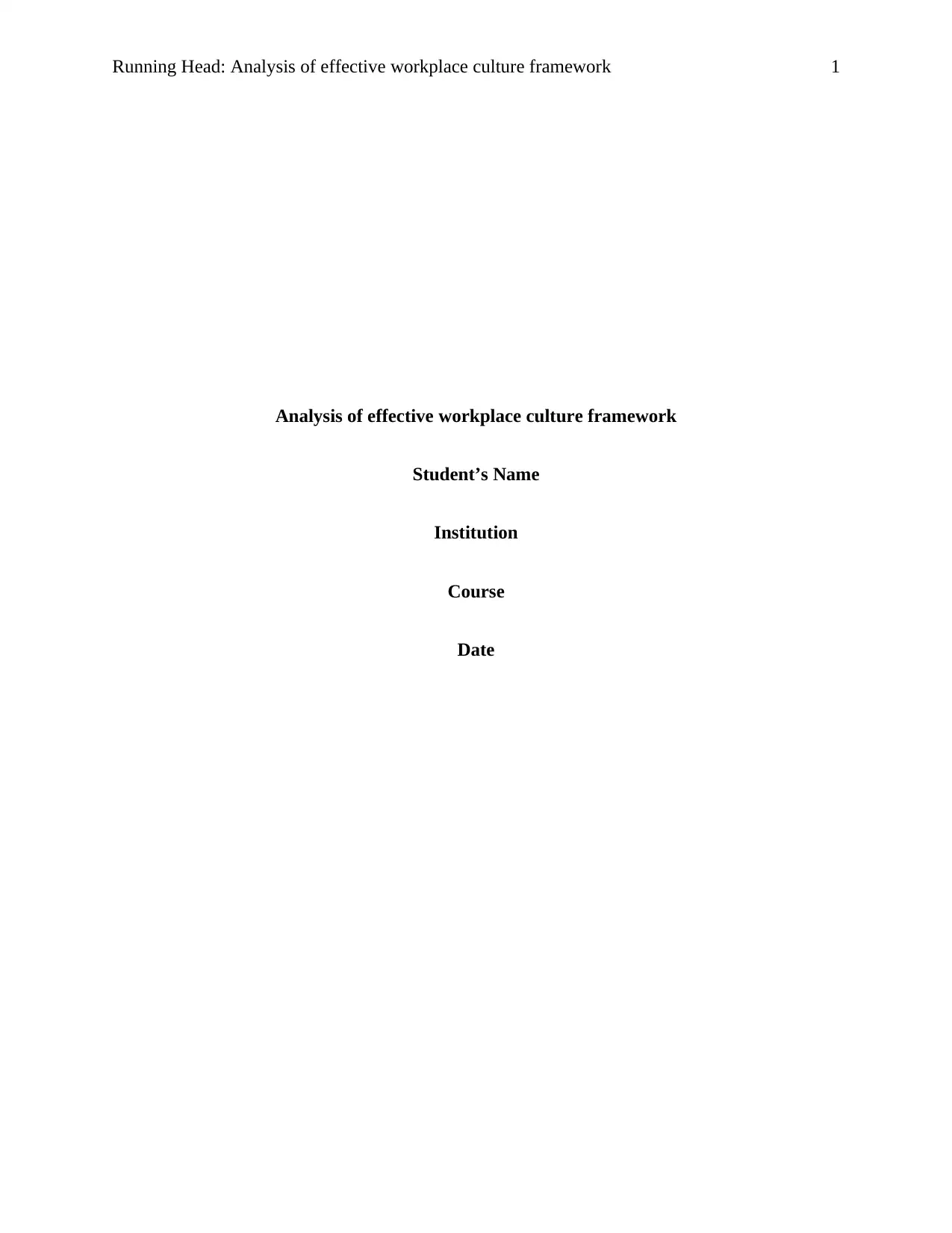
Running Head: Analysis of effective workplace culture framework 1
Analysis of effective workplace culture framework
Student’s Name
Institution
Course
Date
Analysis of effective workplace culture framework
Student’s Name
Institution
Course
Date
Paraphrase This Document
Need a fresh take? Get an instant paraphrase of this document with our AI Paraphraser
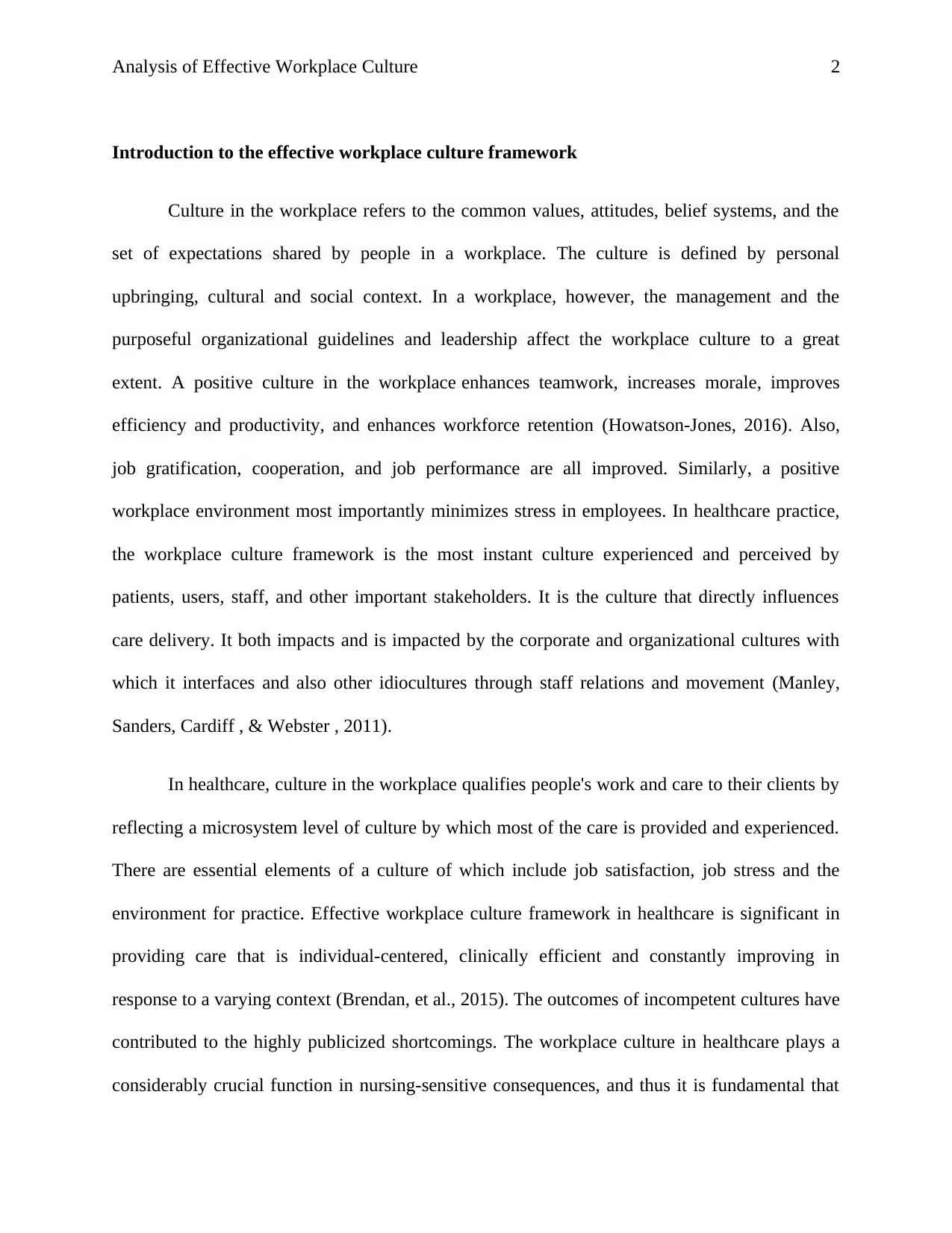
Analysis of Effective Workplace Culture 2
Introduction to the effective workplace culture framework
Culture in the workplace refers to the common values, attitudes, belief systems, and the
set of expectations shared by people in a workplace. The culture is defined by personal
upbringing, cultural and social context. In a workplace, however, the management and the
purposeful organizational guidelines and leadership affect the workplace culture to a great
extent. A positive culture in the workplace enhances teamwork, increases morale, improves
efficiency and productivity, and enhances workforce retention (Howatson-Jones, 2016). Also,
job gratification, cooperation, and job performance are all improved. Similarly, a positive
workplace environment most importantly minimizes stress in employees. In healthcare practice,
the workplace culture framework is the most instant culture experienced and perceived by
patients, users, staff, and other important stakeholders. It is the culture that directly influences
care delivery. It both impacts and is impacted by the corporate and organizational cultures with
which it interfaces and also other idiocultures through staff relations and movement (Manley,
Sanders, Cardiff , & Webster , 2011).
In healthcare, culture in the workplace qualifies people's work and care to their clients by
reflecting a microsystem level of culture by which most of the care is provided and experienced.
There are essential elements of a culture of which include job satisfaction, job stress and the
environment for practice. Effective workplace culture framework in healthcare is significant in
providing care that is individual-centered, clinically efficient and constantly improving in
response to a varying context (Brendan, et al., 2015). The outcomes of incompetent cultures have
contributed to the highly publicized shortcomings. The workplace culture in healthcare plays a
considerably crucial function in nursing-sensitive consequences, and thus it is fundamental that
Introduction to the effective workplace culture framework
Culture in the workplace refers to the common values, attitudes, belief systems, and the
set of expectations shared by people in a workplace. The culture is defined by personal
upbringing, cultural and social context. In a workplace, however, the management and the
purposeful organizational guidelines and leadership affect the workplace culture to a great
extent. A positive culture in the workplace enhances teamwork, increases morale, improves
efficiency and productivity, and enhances workforce retention (Howatson-Jones, 2016). Also,
job gratification, cooperation, and job performance are all improved. Similarly, a positive
workplace environment most importantly minimizes stress in employees. In healthcare practice,
the workplace culture framework is the most instant culture experienced and perceived by
patients, users, staff, and other important stakeholders. It is the culture that directly influences
care delivery. It both impacts and is impacted by the corporate and organizational cultures with
which it interfaces and also other idiocultures through staff relations and movement (Manley,
Sanders, Cardiff , & Webster , 2011).
In healthcare, culture in the workplace qualifies people's work and care to their clients by
reflecting a microsystem level of culture by which most of the care is provided and experienced.
There are essential elements of a culture of which include job satisfaction, job stress and the
environment for practice. Effective workplace culture framework in healthcare is significant in
providing care that is individual-centered, clinically efficient and constantly improving in
response to a varying context (Brendan, et al., 2015). The outcomes of incompetent cultures have
contributed to the highly publicized shortcomings. The workplace culture in healthcare plays a
considerably crucial function in nursing-sensitive consequences, and thus it is fundamental that
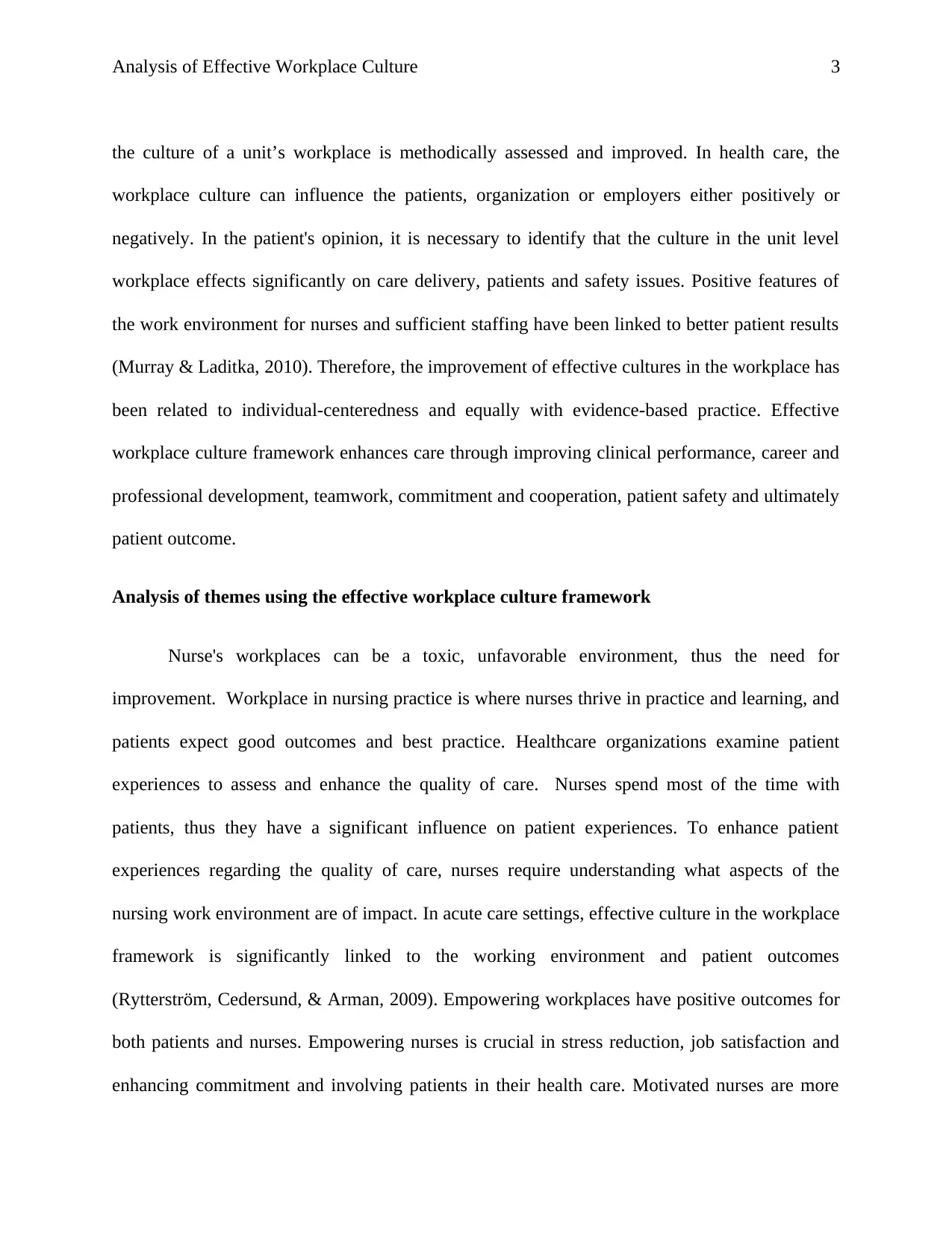
Analysis of Effective Workplace Culture 3
the culture of a unit’s workplace is methodically assessed and improved. In health care, the
workplace culture can influence the patients, organization or employers either positively or
negatively. In the patient's opinion, it is necessary to identify that the culture in the unit level
workplace effects significantly on care delivery, patients and safety issues. Positive features of
the work environment for nurses and sufficient staffing have been linked to better patient results
(Murray & Laditka, 2010). Therefore, the improvement of effective cultures in the workplace has
been related to individual-centeredness and equally with evidence-based practice. Effective
workplace culture framework enhances care through improving clinical performance, career and
professional development, teamwork, commitment and cooperation, patient safety and ultimately
patient outcome.
Analysis of themes using the effective workplace culture framework
Nurse's workplaces can be a toxic, unfavorable environment, thus the need for
improvement. Workplace in nursing practice is where nurses thrive in practice and learning, and
patients expect good outcomes and best practice. Healthcare organizations examine patient
experiences to assess and enhance the quality of care. Nurses spend most of the time with
patients, thus they have a significant influence on patient experiences. To enhance patient
experiences regarding the quality of care, nurses require understanding what aspects of the
nursing work environment are of impact. In acute care settings, effective culture in the workplace
framework is significantly linked to the working environment and patient outcomes
(Rytterström, Cedersund, & Arman, 2009). Empowering workplaces have positive outcomes for
both patients and nurses. Empowering nurses is crucial in stress reduction, job satisfaction and
enhancing commitment and involving patients in their health care. Motivated nurses are more
the culture of a unit’s workplace is methodically assessed and improved. In health care, the
workplace culture can influence the patients, organization or employers either positively or
negatively. In the patient's opinion, it is necessary to identify that the culture in the unit level
workplace effects significantly on care delivery, patients and safety issues. Positive features of
the work environment for nurses and sufficient staffing have been linked to better patient results
(Murray & Laditka, 2010). Therefore, the improvement of effective cultures in the workplace has
been related to individual-centeredness and equally with evidence-based practice. Effective
workplace culture framework enhances care through improving clinical performance, career and
professional development, teamwork, commitment and cooperation, patient safety and ultimately
patient outcome.
Analysis of themes using the effective workplace culture framework
Nurse's workplaces can be a toxic, unfavorable environment, thus the need for
improvement. Workplace in nursing practice is where nurses thrive in practice and learning, and
patients expect good outcomes and best practice. Healthcare organizations examine patient
experiences to assess and enhance the quality of care. Nurses spend most of the time with
patients, thus they have a significant influence on patient experiences. To enhance patient
experiences regarding the quality of care, nurses require understanding what aspects of the
nursing work environment are of impact. In acute care settings, effective culture in the workplace
framework is significantly linked to the working environment and patient outcomes
(Rytterström, Cedersund, & Arman, 2009). Empowering workplaces have positive outcomes for
both patients and nurses. Empowering nurses is crucial in stress reduction, job satisfaction and
enhancing commitment and involving patients in their health care. Motivated nurses are more
⊘ This is a preview!⊘
Do you want full access?
Subscribe today to unlock all pages.

Trusted by 1+ million students worldwide
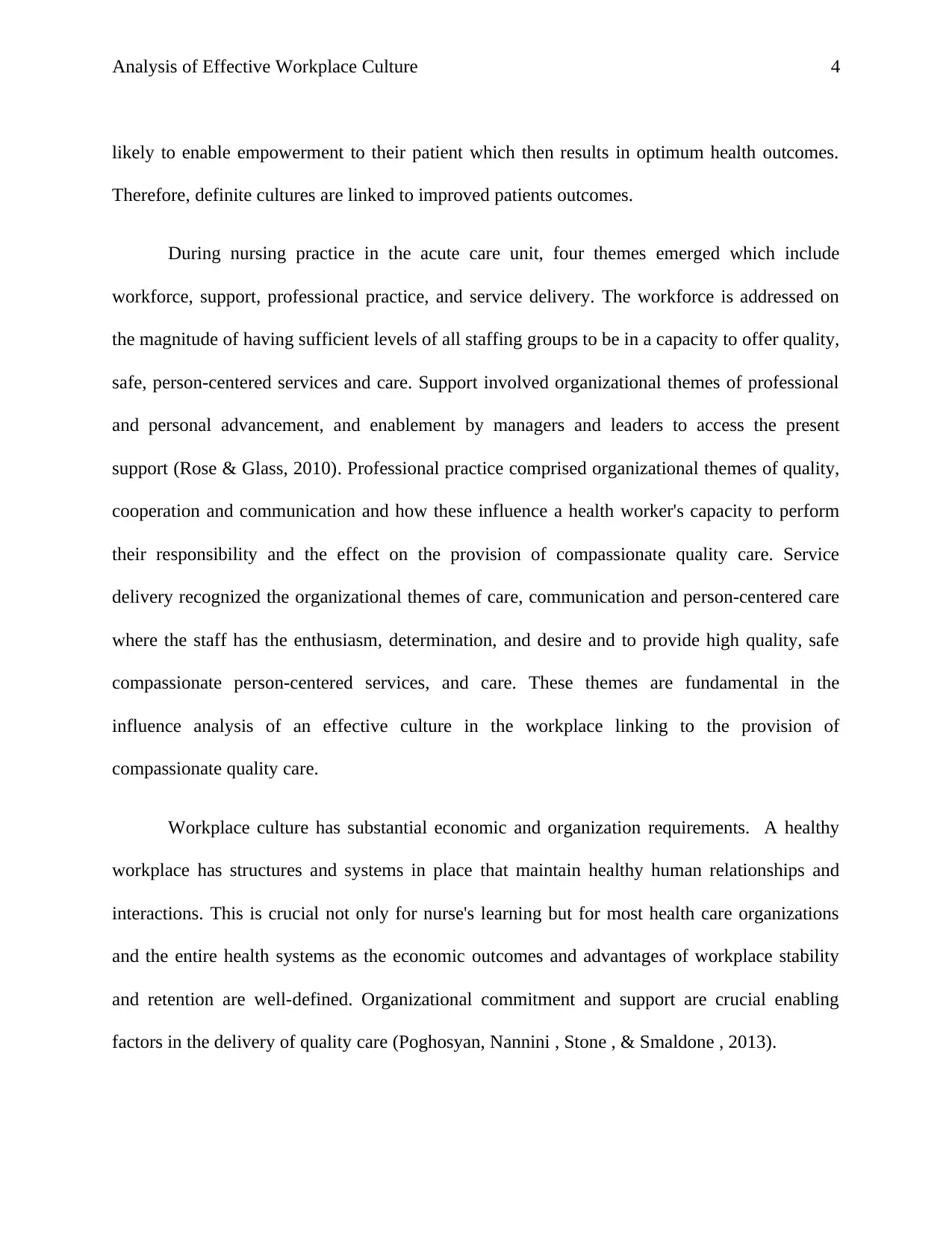
Analysis of Effective Workplace Culture 4
likely to enable empowerment to their patient which then results in optimum health outcomes.
Therefore, definite cultures are linked to improved patients outcomes.
During nursing practice in the acute care unit, four themes emerged which include
workforce, support, professional practice, and service delivery. The workforce is addressed on
the magnitude of having sufficient levels of all staffing groups to be in a capacity to offer quality,
safe, person-centered services and care. Support involved organizational themes of professional
and personal advancement, and enablement by managers and leaders to access the present
support (Rose & Glass, 2010). Professional practice comprised organizational themes of quality,
cooperation and communication and how these influence a health worker's capacity to perform
their responsibility and the effect on the provision of compassionate quality care. Service
delivery recognized the organizational themes of care, communication and person-centered care
where the staff has the enthusiasm, determination, and desire and to provide high quality, safe
compassionate person-centered services, and care. These themes are fundamental in the
influence analysis of an effective culture in the workplace linking to the provision of
compassionate quality care.
Workplace culture has substantial economic and organization requirements. A healthy
workplace has structures and systems in place that maintain healthy human relationships and
interactions. This is crucial not only for nurse's learning but for most health care organizations
and the entire health systems as the economic outcomes and advantages of workplace stability
and retention are well-defined. Organizational commitment and support are crucial enabling
factors in the delivery of quality care (Poghosyan, Nannini , Stone , & Smaldone , 2013).
likely to enable empowerment to their patient which then results in optimum health outcomes.
Therefore, definite cultures are linked to improved patients outcomes.
During nursing practice in the acute care unit, four themes emerged which include
workforce, support, professional practice, and service delivery. The workforce is addressed on
the magnitude of having sufficient levels of all staffing groups to be in a capacity to offer quality,
safe, person-centered services and care. Support involved organizational themes of professional
and personal advancement, and enablement by managers and leaders to access the present
support (Rose & Glass, 2010). Professional practice comprised organizational themes of quality,
cooperation and communication and how these influence a health worker's capacity to perform
their responsibility and the effect on the provision of compassionate quality care. Service
delivery recognized the organizational themes of care, communication and person-centered care
where the staff has the enthusiasm, determination, and desire and to provide high quality, safe
compassionate person-centered services, and care. These themes are fundamental in the
influence analysis of an effective culture in the workplace linking to the provision of
compassionate quality care.
Workplace culture has substantial economic and organization requirements. A healthy
workplace has structures and systems in place that maintain healthy human relationships and
interactions. This is crucial not only for nurse's learning but for most health care organizations
and the entire health systems as the economic outcomes and advantages of workplace stability
and retention are well-defined. Organizational commitment and support are crucial enabling
factors in the delivery of quality care (Poghosyan, Nannini , Stone , & Smaldone , 2013).
Paraphrase This Document
Need a fresh take? Get an instant paraphrase of this document with our AI Paraphraser
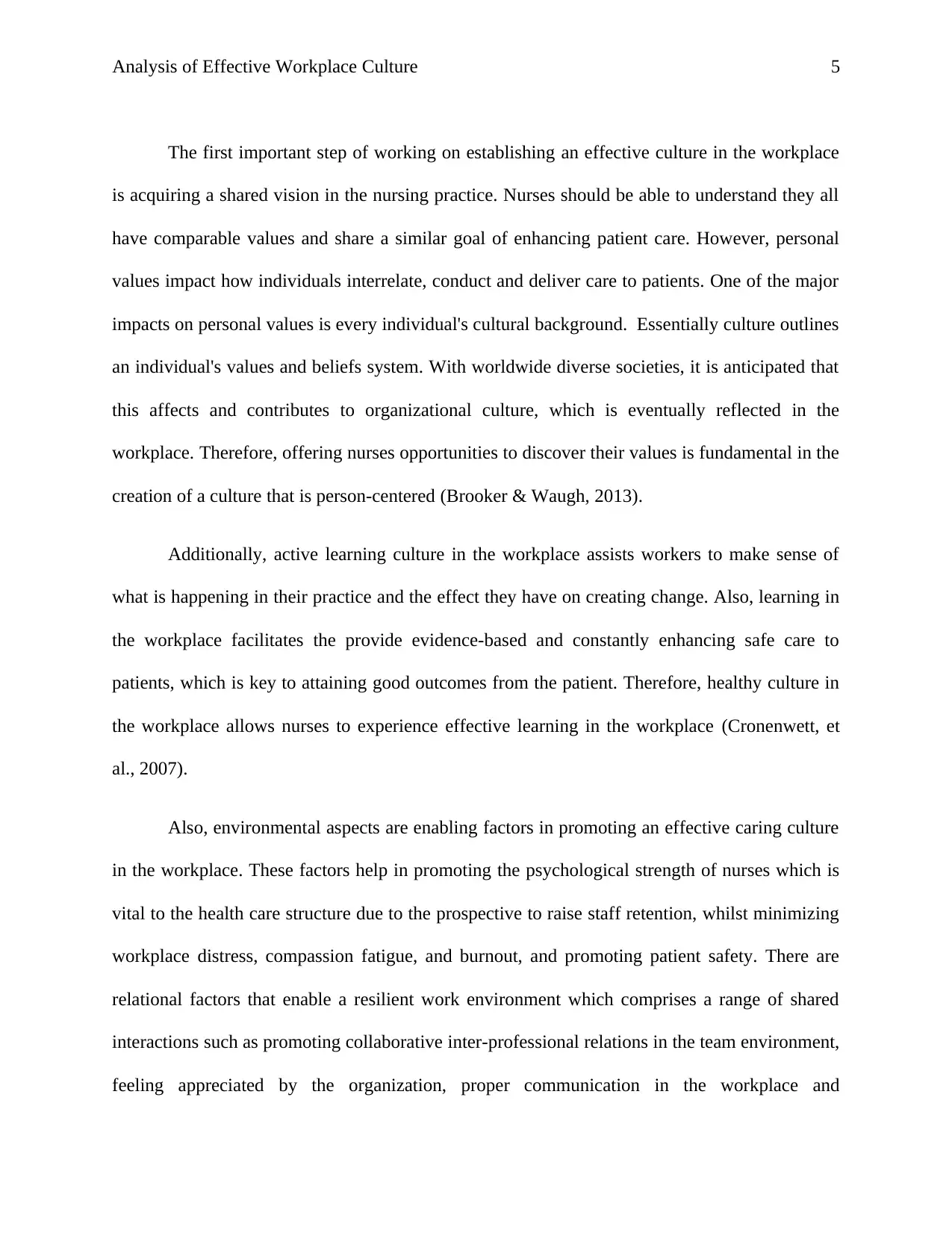
Analysis of Effective Workplace Culture 5
The first important step of working on establishing an effective culture in the workplace
is acquiring a shared vision in the nursing practice. Nurses should be able to understand they all
have comparable values and share a similar goal of enhancing patient care. However, personal
values impact how individuals interrelate, conduct and deliver care to patients. One of the major
impacts on personal values is every individual's cultural background. Essentially culture outlines
an individual's values and beliefs system. With worldwide diverse societies, it is anticipated that
this affects and contributes to organizational culture, which is eventually reflected in the
workplace. Therefore, offering nurses opportunities to discover their values is fundamental in the
creation of a culture that is person-centered (Brooker & Waugh, 2013).
Additionally, active learning culture in the workplace assists workers to make sense of
what is happening in their practice and the effect they have on creating change. Also, learning in
the workplace facilitates the provide evidence-based and constantly enhancing safe care to
patients, which is key to attaining good outcomes from the patient. Therefore, healthy culture in
the workplace allows nurses to experience effective learning in the workplace (Cronenwett, et
al., 2007).
Also, environmental aspects are enabling factors in promoting an effective caring culture
in the workplace. These factors help in promoting the psychological strength of nurses which is
vital to the health care structure due to the prospective to raise staff retention, whilst minimizing
workplace distress, compassion fatigue, and burnout, and promoting patient safety. There are
relational factors that enable a resilient work environment which comprises a range of shared
interactions such as promoting collaborative inter-professional relations in the team environment,
feeling appreciated by the organization, proper communication in the workplace and
The first important step of working on establishing an effective culture in the workplace
is acquiring a shared vision in the nursing practice. Nurses should be able to understand they all
have comparable values and share a similar goal of enhancing patient care. However, personal
values impact how individuals interrelate, conduct and deliver care to patients. One of the major
impacts on personal values is every individual's cultural background. Essentially culture outlines
an individual's values and beliefs system. With worldwide diverse societies, it is anticipated that
this affects and contributes to organizational culture, which is eventually reflected in the
workplace. Therefore, offering nurses opportunities to discover their values is fundamental in the
creation of a culture that is person-centered (Brooker & Waugh, 2013).
Additionally, active learning culture in the workplace assists workers to make sense of
what is happening in their practice and the effect they have on creating change. Also, learning in
the workplace facilitates the provide evidence-based and constantly enhancing safe care to
patients, which is key to attaining good outcomes from the patient. Therefore, healthy culture in
the workplace allows nurses to experience effective learning in the workplace (Cronenwett, et
al., 2007).
Also, environmental aspects are enabling factors in promoting an effective caring culture
in the workplace. These factors help in promoting the psychological strength of nurses which is
vital to the health care structure due to the prospective to raise staff retention, whilst minimizing
workplace distress, compassion fatigue, and burnout, and promoting patient safety. There are
relational factors that enable a resilient work environment which comprises a range of shared
interactions such as promoting collaborative inter-professional relations in the team environment,
feeling appreciated by the organization, proper communication in the workplace and
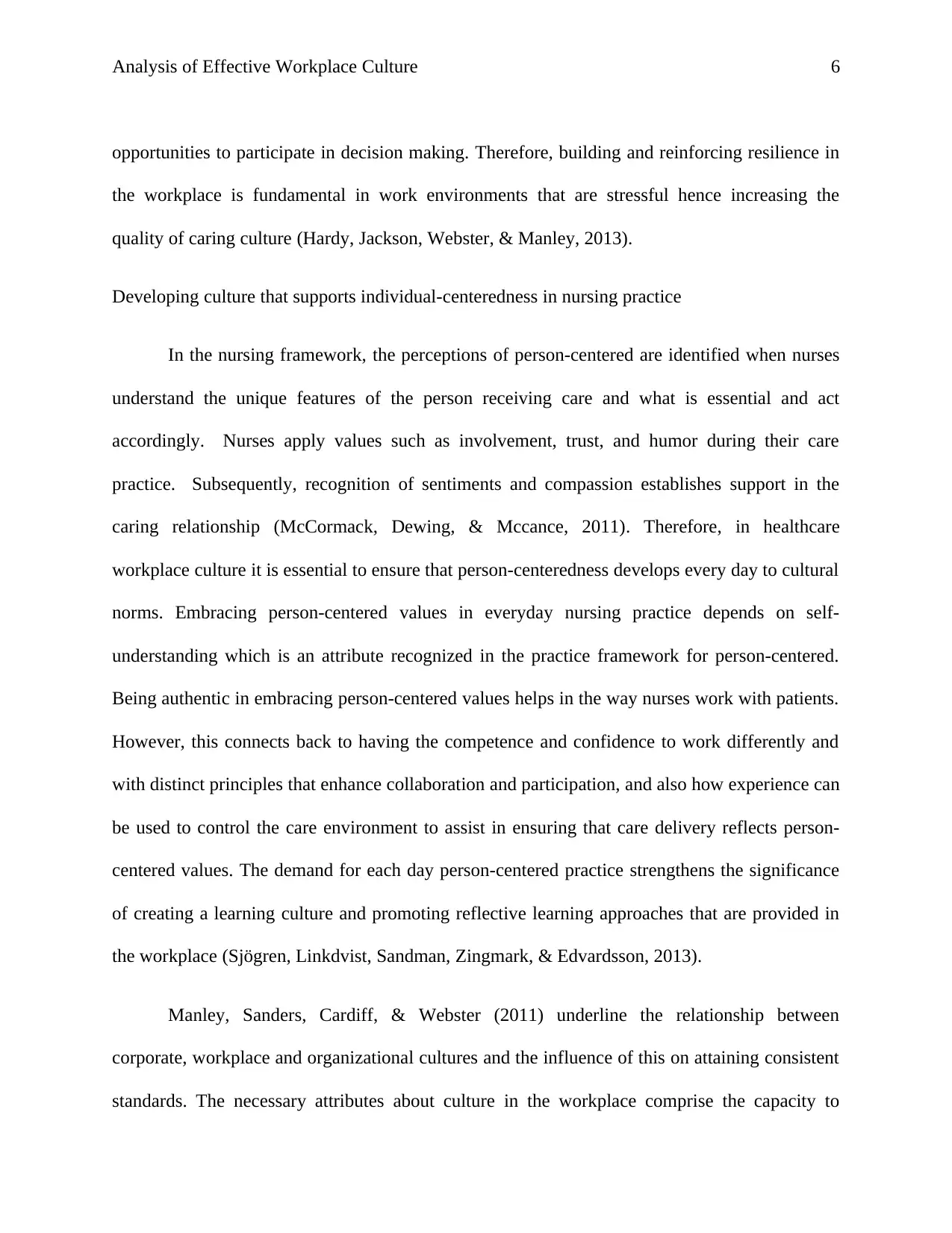
Analysis of Effective Workplace Culture 6
opportunities to participate in decision making. Therefore, building and reinforcing resilience in
the workplace is fundamental in work environments that are stressful hence increasing the
quality of caring culture (Hardy, Jackson, Webster, & Manley, 2013).
Developing culture that supports individual-centeredness in nursing practice
In the nursing framework, the perceptions of person-centered are identified when nurses
understand the unique features of the person receiving care and what is essential and act
accordingly. Nurses apply values such as involvement, trust, and humor during their care
practice. Subsequently, recognition of sentiments and compassion establishes support in the
caring relationship (McCormack, Dewing, & Mccance, 2011). Therefore, in healthcare
workplace culture it is essential to ensure that person-centeredness develops every day to cultural
norms. Embracing person-centered values in everyday nursing practice depends on self-
understanding which is an attribute recognized in the practice framework for person-centered.
Being authentic in embracing person-centered values helps in the way nurses work with patients.
However, this connects back to having the competence and confidence to work differently and
with distinct principles that enhance collaboration and participation, and also how experience can
be used to control the care environment to assist in ensuring that care delivery reflects person-
centered values. The demand for each day person-centered practice strengthens the significance
of creating a learning culture and promoting reflective learning approaches that are provided in
the workplace (Sjögren, Linkdvist, Sandman, Zingmark, & Edvardsson, 2013).
Manley, Sanders, Cardiff, & Webster (2011) underline the relationship between
corporate, workplace and organizational cultures and the influence of this on attaining consistent
standards. The necessary attributes about culture in the workplace comprise the capacity to
opportunities to participate in decision making. Therefore, building and reinforcing resilience in
the workplace is fundamental in work environments that are stressful hence increasing the
quality of caring culture (Hardy, Jackson, Webster, & Manley, 2013).
Developing culture that supports individual-centeredness in nursing practice
In the nursing framework, the perceptions of person-centered are identified when nurses
understand the unique features of the person receiving care and what is essential and act
accordingly. Nurses apply values such as involvement, trust, and humor during their care
practice. Subsequently, recognition of sentiments and compassion establishes support in the
caring relationship (McCormack, Dewing, & Mccance, 2011). Therefore, in healthcare
workplace culture it is essential to ensure that person-centeredness develops every day to cultural
norms. Embracing person-centered values in everyday nursing practice depends on self-
understanding which is an attribute recognized in the practice framework for person-centered.
Being authentic in embracing person-centered values helps in the way nurses work with patients.
However, this connects back to having the competence and confidence to work differently and
with distinct principles that enhance collaboration and participation, and also how experience can
be used to control the care environment to assist in ensuring that care delivery reflects person-
centered values. The demand for each day person-centered practice strengthens the significance
of creating a learning culture and promoting reflective learning approaches that are provided in
the workplace (Sjögren, Linkdvist, Sandman, Zingmark, & Edvardsson, 2013).
Manley, Sanders, Cardiff, & Webster (2011) underline the relationship between
corporate, workplace and organizational cultures and the influence of this on attaining consistent
standards. The necessary attributes about culture in the workplace comprise the capacity to
⊘ This is a preview!⊘
Do you want full access?
Subscribe today to unlock all pages.

Trusted by 1+ million students worldwide
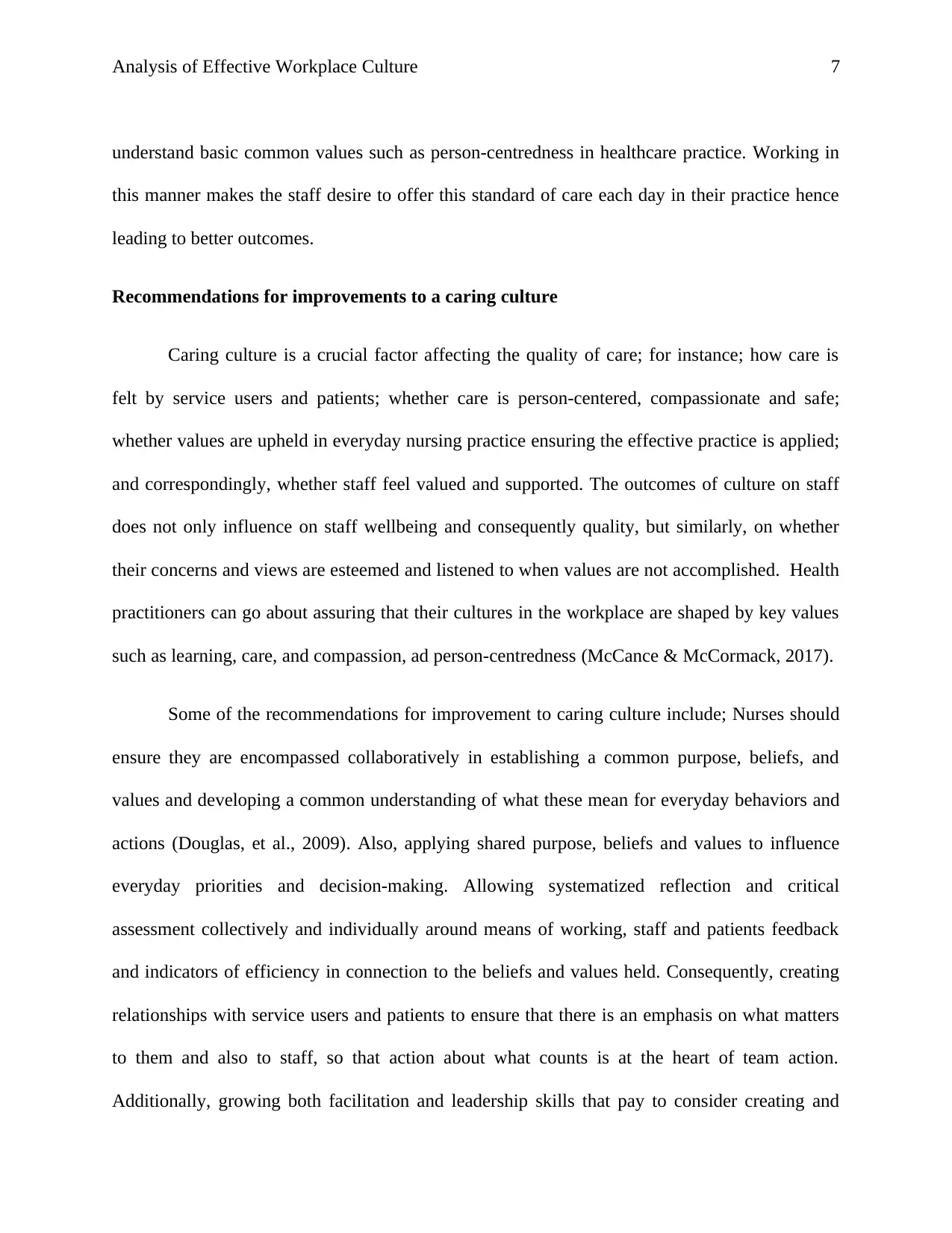
Analysis of Effective Workplace Culture 7
understand basic common values such as person-centredness in healthcare practice. Working in
this manner makes the staff desire to offer this standard of care each day in their practice hence
leading to better outcomes.
Recommendations for improvements to a caring culture
Caring culture is a crucial factor affecting the quality of care; for instance; how care is
felt by service users and patients; whether care is person-centered, compassionate and safe;
whether values are upheld in everyday nursing practice ensuring the effective practice is applied;
and correspondingly, whether staff feel valued and supported. The outcomes of culture on staff
does not only influence on staff wellbeing and consequently quality, but similarly, on whether
their concerns and views are esteemed and listened to when values are not accomplished. Health
practitioners can go about assuring that their cultures in the workplace are shaped by key values
such as learning, care, and compassion, ad person-centredness (McCance & McCormack, 2017).
Some of the recommendations for improvement to caring culture include; Nurses should
ensure they are encompassed collaboratively in establishing a common purpose, beliefs, and
values and developing a common understanding of what these mean for everyday behaviors and
actions (Douglas, et al., 2009). Also, applying shared purpose, beliefs and values to influence
everyday priorities and decision-making. Allowing systematized reflection and critical
assessment collectively and individually around means of working, staff and patients feedback
and indicators of efficiency in connection to the beliefs and values held. Consequently, creating
relationships with service users and patients to ensure that there is an emphasis on what matters
to them and also to staff, so that action about what counts is at the heart of team action.
Additionally, growing both facilitation and leadership skills that pay to consider creating and
understand basic common values such as person-centredness in healthcare practice. Working in
this manner makes the staff desire to offer this standard of care each day in their practice hence
leading to better outcomes.
Recommendations for improvements to a caring culture
Caring culture is a crucial factor affecting the quality of care; for instance; how care is
felt by service users and patients; whether care is person-centered, compassionate and safe;
whether values are upheld in everyday nursing practice ensuring the effective practice is applied;
and correspondingly, whether staff feel valued and supported. The outcomes of culture on staff
does not only influence on staff wellbeing and consequently quality, but similarly, on whether
their concerns and views are esteemed and listened to when values are not accomplished. Health
practitioners can go about assuring that their cultures in the workplace are shaped by key values
such as learning, care, and compassion, ad person-centredness (McCance & McCormack, 2017).
Some of the recommendations for improvement to caring culture include; Nurses should
ensure they are encompassed collaboratively in establishing a common purpose, beliefs, and
values and developing a common understanding of what these mean for everyday behaviors and
actions (Douglas, et al., 2009). Also, applying shared purpose, beliefs and values to influence
everyday priorities and decision-making. Allowing systematized reflection and critical
assessment collectively and individually around means of working, staff and patients feedback
and indicators of efficiency in connection to the beliefs and values held. Consequently, creating
relationships with service users and patients to ensure that there is an emphasis on what matters
to them and also to staff, so that action about what counts is at the heart of team action.
Additionally, growing both facilitation and leadership skills that pay to consider creating and
Paraphrase This Document
Need a fresh take? Get an instant paraphrase of this document with our AI Paraphraser
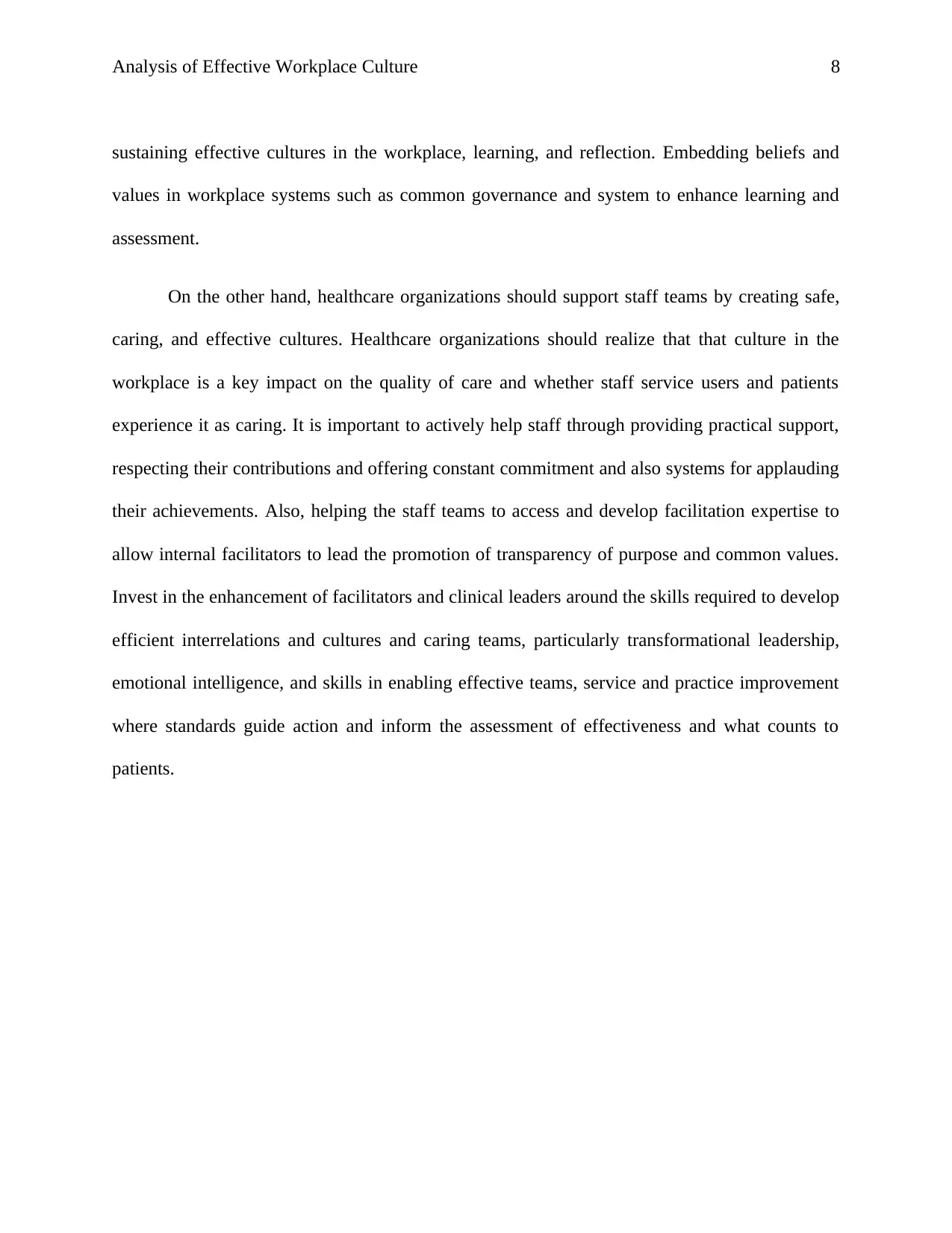
Analysis of Effective Workplace Culture 8
sustaining effective cultures in the workplace, learning, and reflection. Embedding beliefs and
values in workplace systems such as common governance and system to enhance learning and
assessment.
On the other hand, healthcare organizations should support staff teams by creating safe,
caring, and effective cultures. Healthcare organizations should realize that that culture in the
workplace is a key impact on the quality of care and whether staff service users and patients
experience it as caring. It is important to actively help staff through providing practical support,
respecting their contributions and offering constant commitment and also systems for applauding
their achievements. Also, helping the staff teams to access and develop facilitation expertise to
allow internal facilitators to lead the promotion of transparency of purpose and common values.
Invest in the enhancement of facilitators and clinical leaders around the skills required to develop
efficient interrelations and cultures and caring teams, particularly transformational leadership,
emotional intelligence, and skills in enabling effective teams, service and practice improvement
where standards guide action and inform the assessment of effectiveness and what counts to
patients.
sustaining effective cultures in the workplace, learning, and reflection. Embedding beliefs and
values in workplace systems such as common governance and system to enhance learning and
assessment.
On the other hand, healthcare organizations should support staff teams by creating safe,
caring, and effective cultures. Healthcare organizations should realize that that culture in the
workplace is a key impact on the quality of care and whether staff service users and patients
experience it as caring. It is important to actively help staff through providing practical support,
respecting their contributions and offering constant commitment and also systems for applauding
their achievements. Also, helping the staff teams to access and develop facilitation expertise to
allow internal facilitators to lead the promotion of transparency of purpose and common values.
Invest in the enhancement of facilitators and clinical leaders around the skills required to develop
efficient interrelations and cultures and caring teams, particularly transformational leadership,
emotional intelligence, and skills in enabling effective teams, service and practice improvement
where standards guide action and inform the assessment of effectiveness and what counts to
patients.
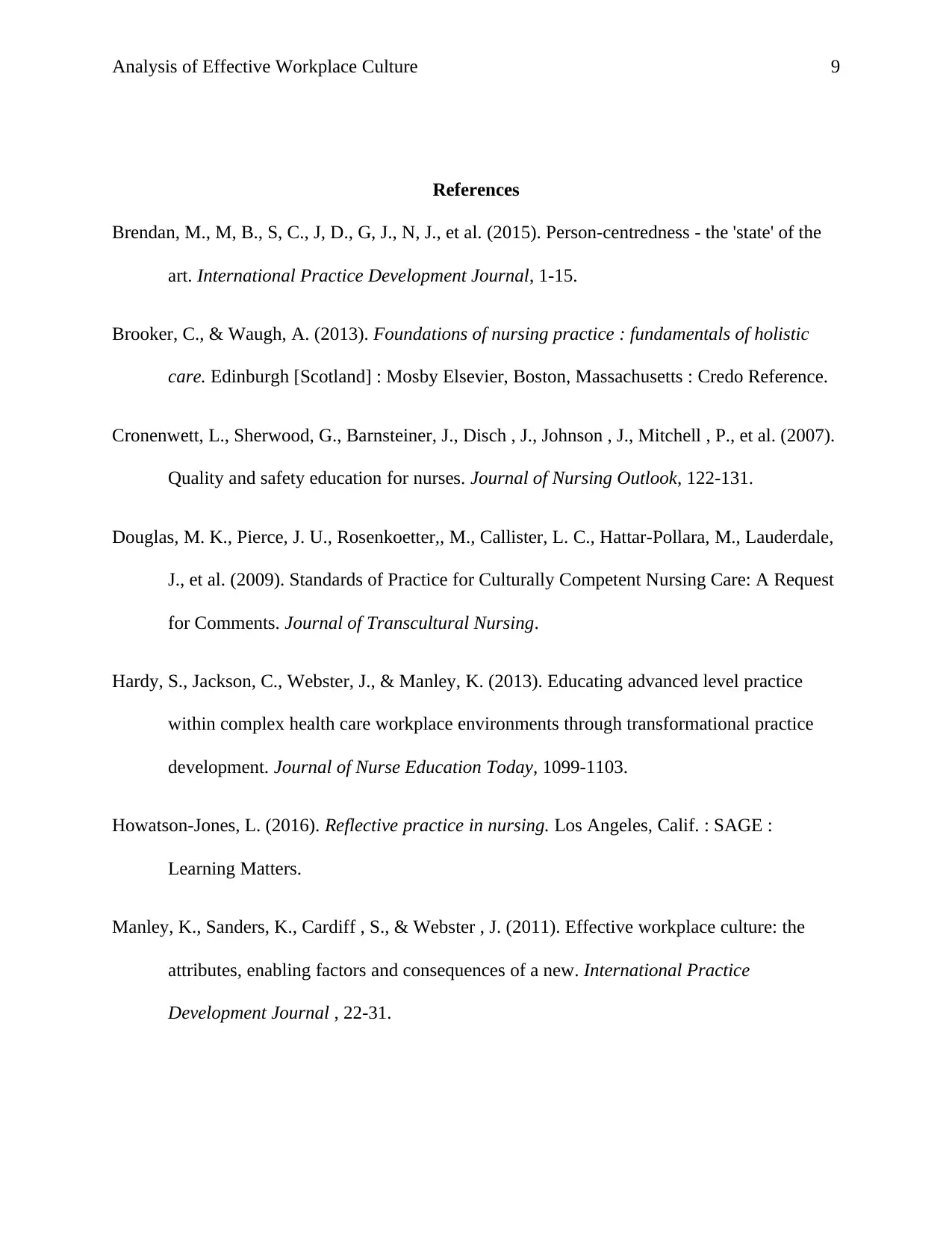
Analysis of Effective Workplace Culture 9
References
Brendan, M., M, B., S, C., J, D., G, J., N, J., et al. (2015). Person-centredness - the 'state' of the
art. International Practice Development Journal, 1-15.
Brooker, C., & Waugh, A. (2013). Foundations of nursing practice : fundamentals of holistic
care. Edinburgh [Scotland] : Mosby Elsevier, Boston, Massachusetts : Credo Reference.
Cronenwett, L., Sherwood, G., Barnsteiner, J., Disch , J., Johnson , J., Mitchell , P., et al. (2007).
Quality and safety education for nurses. Journal of Nursing Outlook, 122-131.
Douglas, M. K., Pierce, J. U., Rosenkoetter,, M., Callister, L. C., Hattar-Pollara, M., Lauderdale,
J., et al. (2009). Standards of Practice for Culturally Competent Nursing Care: A Request
for Comments. Journal of Transcultural Nursing.
Hardy, S., Jackson, C., Webster, J., & Manley, K. (2013). Educating advanced level practice
within complex health care workplace environments through transformational practice
development. Journal of Nurse Education Today, 1099-1103.
Howatson-Jones, L. (2016). Reflective practice in nursing. Los Angeles, Calif. : SAGE :
Learning Matters.
Manley, K., Sanders, K., Cardiff , S., & Webster , J. (2011). Effective workplace culture: the
attributes, enabling factors and consequences of a new. International Practice
Development Journal , 22-31.
References
Brendan, M., M, B., S, C., J, D., G, J., N, J., et al. (2015). Person-centredness - the 'state' of the
art. International Practice Development Journal, 1-15.
Brooker, C., & Waugh, A. (2013). Foundations of nursing practice : fundamentals of holistic
care. Edinburgh [Scotland] : Mosby Elsevier, Boston, Massachusetts : Credo Reference.
Cronenwett, L., Sherwood, G., Barnsteiner, J., Disch , J., Johnson , J., Mitchell , P., et al. (2007).
Quality and safety education for nurses. Journal of Nursing Outlook, 122-131.
Douglas, M. K., Pierce, J. U., Rosenkoetter,, M., Callister, L. C., Hattar-Pollara, M., Lauderdale,
J., et al. (2009). Standards of Practice for Culturally Competent Nursing Care: A Request
for Comments. Journal of Transcultural Nursing.
Hardy, S., Jackson, C., Webster, J., & Manley, K. (2013). Educating advanced level practice
within complex health care workplace environments through transformational practice
development. Journal of Nurse Education Today, 1099-1103.
Howatson-Jones, L. (2016). Reflective practice in nursing. Los Angeles, Calif. : SAGE :
Learning Matters.
Manley, K., Sanders, K., Cardiff , S., & Webster , J. (2011). Effective workplace culture: the
attributes, enabling factors and consequences of a new. International Practice
Development Journal , 22-31.
⊘ This is a preview!⊘
Do you want full access?
Subscribe today to unlock all pages.

Trusted by 1+ million students worldwide
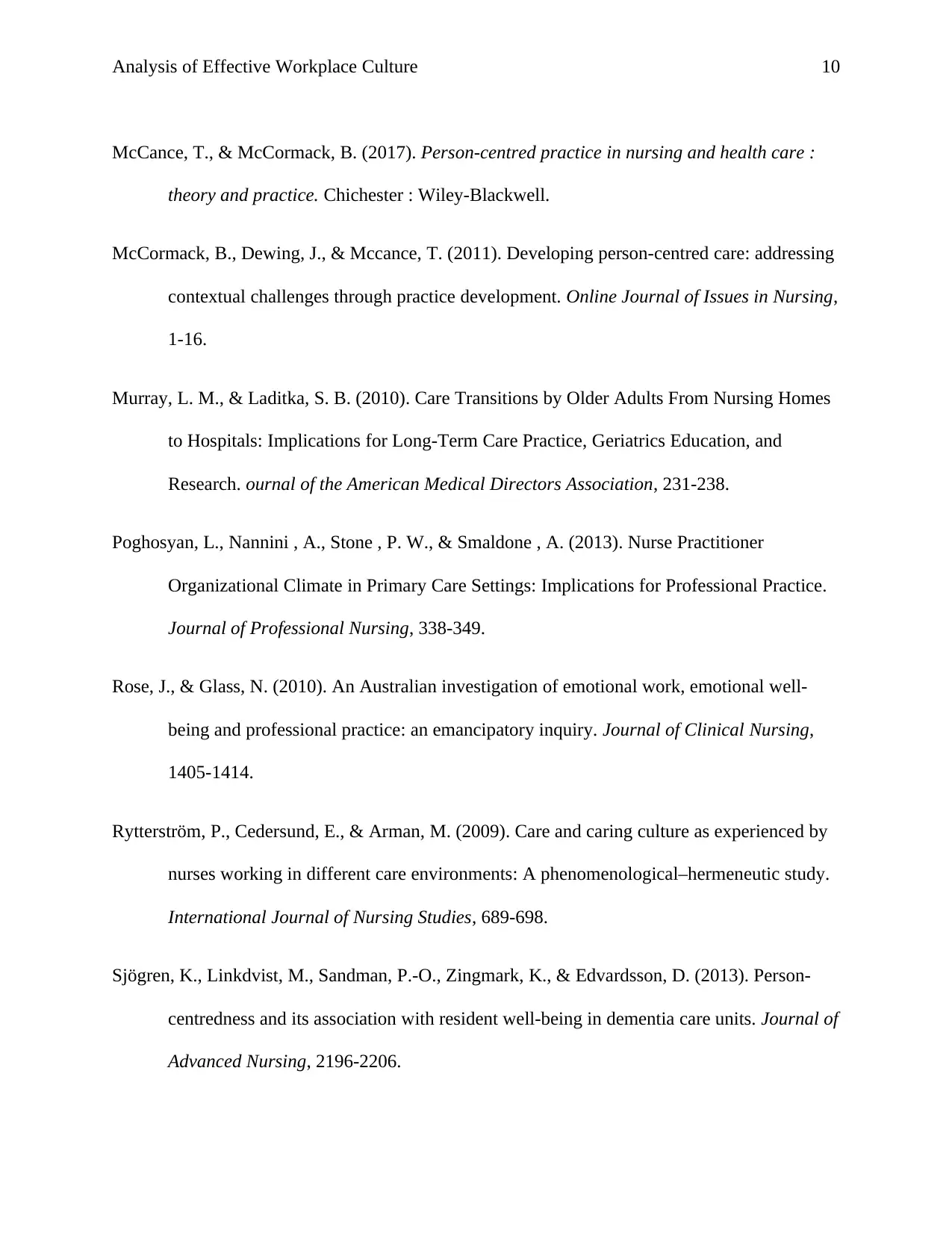
Analysis of Effective Workplace Culture 10
McCance, T., & McCormack, B. (2017). Person-centred practice in nursing and health care :
theory and practice. Chichester : Wiley-Blackwell.
McCormack, B., Dewing, J., & Mccance, T. (2011). Developing person-centred care: addressing
contextual challenges through practice development. Online Journal of Issues in Nursing,
1-16.
Murray, L. M., & Laditka, S. B. (2010). Care Transitions by Older Adults From Nursing Homes
to Hospitals: Implications for Long-Term Care Practice, Geriatrics Education, and
Research. ournal of the American Medical Directors Association, 231-238.
Poghosyan, L., Nannini , A., Stone , P. W., & Smaldone , A. (2013). Nurse Practitioner
Organizational Climate in Primary Care Settings: Implications for Professional Practice.
Journal of Professional Nursing, 338-349.
Rose, J., & Glass, N. (2010). An Australian investigation of emotional work, emotional well‐
being and professional practice: an emancipatory inquiry. Journal of Clinical Nursing,
1405-1414.
Rytterström, P., Cedersund, E., & Arman, M. (2009). Care and caring culture as experienced by
nurses working in different care environments: A phenomenological–hermeneutic study.
International Journal of Nursing Studies, 689-698.
Sjögren, K., Linkdvist, M., Sandman, P.-O., Zingmark, K., & Edvardsson, D. (2013). Person‐
centredness and its association with resident well‐being in dementia care units. Journal of
Advanced Nursing, 2196-2206.
McCance, T., & McCormack, B. (2017). Person-centred practice in nursing and health care :
theory and practice. Chichester : Wiley-Blackwell.
McCormack, B., Dewing, J., & Mccance, T. (2011). Developing person-centred care: addressing
contextual challenges through practice development. Online Journal of Issues in Nursing,
1-16.
Murray, L. M., & Laditka, S. B. (2010). Care Transitions by Older Adults From Nursing Homes
to Hospitals: Implications for Long-Term Care Practice, Geriatrics Education, and
Research. ournal of the American Medical Directors Association, 231-238.
Poghosyan, L., Nannini , A., Stone , P. W., & Smaldone , A. (2013). Nurse Practitioner
Organizational Climate in Primary Care Settings: Implications for Professional Practice.
Journal of Professional Nursing, 338-349.
Rose, J., & Glass, N. (2010). An Australian investigation of emotional work, emotional well‐
being and professional practice: an emancipatory inquiry. Journal of Clinical Nursing,
1405-1414.
Rytterström, P., Cedersund, E., & Arman, M. (2009). Care and caring culture as experienced by
nurses working in different care environments: A phenomenological–hermeneutic study.
International Journal of Nursing Studies, 689-698.
Sjögren, K., Linkdvist, M., Sandman, P.-O., Zingmark, K., & Edvardsson, D. (2013). Person‐
centredness and its association with resident well‐being in dementia care units. Journal of
Advanced Nursing, 2196-2206.
Paraphrase This Document
Need a fresh take? Get an instant paraphrase of this document with our AI Paraphraser

Analysis of Effective Workplace Culture 11
1 out of 11
Related Documents
Your All-in-One AI-Powered Toolkit for Academic Success.
+13062052269
info@desklib.com
Available 24*7 on WhatsApp / Email
![[object Object]](/_next/static/media/star-bottom.7253800d.svg)
Unlock your academic potential
Copyright © 2020–2025 A2Z Services. All Rights Reserved. Developed and managed by ZUCOL.





